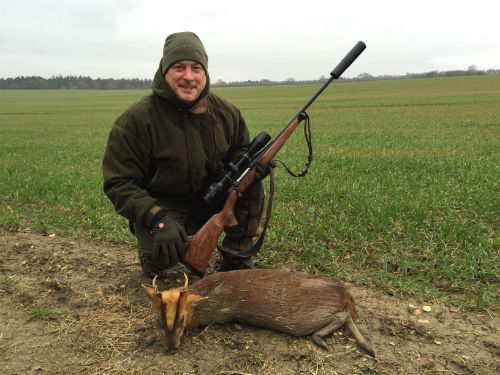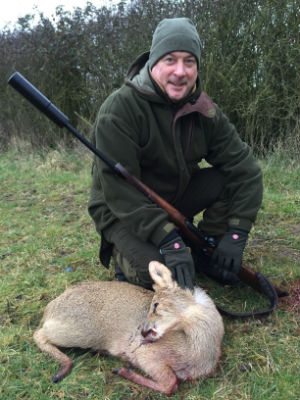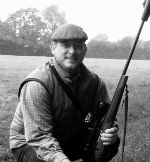Further to our article last month in which James Mott discussed how to zero your rifle, James Schneider illustrates the importance of taking these principles into the field.

(Above: James in action with his Sauer 202 in 6.5x55 and Swarovski Scope)
Stalking can be a highly physical and demanding endeavor, and over the course of regular outings my trusty Sauer 202 in 6.5x55mm will take several bumps and bangs as I crawl through brush and across any number of obstacles. Where weeks before I was bang-on zero at 100 metres, inevitably the day-to-day strains of the job are bound to cause variation to maintaining zero, as the scope and mounts absorb repeated, albeit often minimal impacts that add up over time.
The effect of losing zero can be highly unfortunate and may result in poorly shot animals who potentially may suffer a painful end, or be wounded badly, only to run off and never be recovered. Thankfully this was not the case for me on two recent stalks, rather the frustration of twice missing the same Roe doe in as many weeks, while managing the cull on my Hampshire lease this past February. Said doe emerged at the same time from the same spot on each occasion; there was me, waiting on my sticks, range established at 105 metres, breathing under control and a slow exhale while I gently squeezed the trigger only to be met with the hard “thwack” of a clean miss rather than a satisfying thud and resulting culled animal.
Frustrated with this result, it was clear I had a problem with my zero and I was looking forward to an upcoming range day with the Capreolus club at the West London Shooting School to investigate the matter further.
 With rifle secured in the Club’s “Lead Sled”, I quickly identified the issue as my Swarovski optics had me sending my rounds a good three inches left and two inches high at 100 metres! On a small Roe doe at similar distance, my rounds were passing well in front of the beast each time causing her a fright, and me much annoyance.
With rifle secured in the Club’s “Lead Sled”, I quickly identified the issue as my Swarovski optics had me sending my rounds a good three inches left and two inches high at 100 metres! On a small Roe doe at similar distance, my rounds were passing well in front of the beast each time causing her a fright, and me much annoyance.
(Left: A cleanly shot Bronze Medal CWD)
Modern optics are highly sophisticated in their construction and capabilities, and I was pleased to benefit from the technical expertise of County Deer Stalking’s James Mott who applied his Swarovski product knowledge to correctly tune my scope and realign my point of aim with point of impact. After various adjustments to windage and elevation, combined with further tuning based on the brand and weight of my ammunition via Swarovski’s on-line zeroing application, I was soon firing a clean group dead-on at 100 metres. A final few shots to confirm all in order, and I was ready to resume my stalking with the confidence that my rifle and optics were as accurate as they would ever be.
The opportunity to put these efforts to the test arrived a few days later as I joined several other Capreolus Club members for a memorable stalk near Woburn Abbey. Keen to pursue Chinese Water Deer as the only UK species I had yet to encounter, Woburn is also famous for its high density of Fallow and Muntjac; the latter being its most famous (or infamous) escapee, having jumped ship from the Abbey in 1925 and breeding prolifically ever since.
The morning started out cold and overcast, and as I trudged through the early gloom my mind wandered and I found myself looking forward to a nice warm beach holiday with a strong fruity cocktail of some sort after a long, nasty winter. Reality snapped me back into place as a Muntjac doe emerged from the foliage. I checked range and dialed in my scope to 200 metres, placed the cross hairs and squeezed. The resulting thud told the tale as the doe was cleanly culled.
With the morning still fresh, the location of the felled doe was marked for gralloch later and the stalk continued down the hedge. Across the field a Chinese Water Deer could be seen grazing, and I again dialed in the range on the Swarovski scope as James Mott had instructed me. Range at 210 metres, a clean shot and I was hugely chuffed as my first CWD was grassed; the second deer of the morning and a Bronze Medal head!
Very pleased with the result, it was time to sort the venison, but not before a nice representative Muntjac buck came into view running along a grassy area to our right. Yet again on the sticks and range established at 120 metres, scope adjusted and another clean shot saw the third beast of the morning culled in no time. An action packed morning with an excellent result.
In summary, a large amount of Sterling can easily be invested in kit, optics and outings as part of pursuing the art that is deer stalking. With that in mind, and likewise the ethical considerations around ensuring quarry are cleanly dispatched, it certainly pays dividend to ensure all of the tools we use are as effectively deployed as possible. For me, time at the range and expert advice on tuning optics for zero resulted in a fantastic outing with my Sauer and Swarovski combination, once again reminding me of their value as I looked over the spoils of the stalk.
 As we get ready for the peak of the Roe buck season, I would recommend others do the same and ensure one’s kit is as accurate as possible in anticipation of a successful season.
As we get ready for the peak of the Roe buck season, I would recommend others do the same and ensure one’s kit is as accurate as possible in anticipation of a successful season.
To read more from James follow this link in which he considers two lesser known calibres for the highlands: david-lloyd-calibres-a-cure-for-scottish-wind
Alternatively to watch a film in which we demonstarte how to zero a rifle, follow this link to our training films page: training-films



















